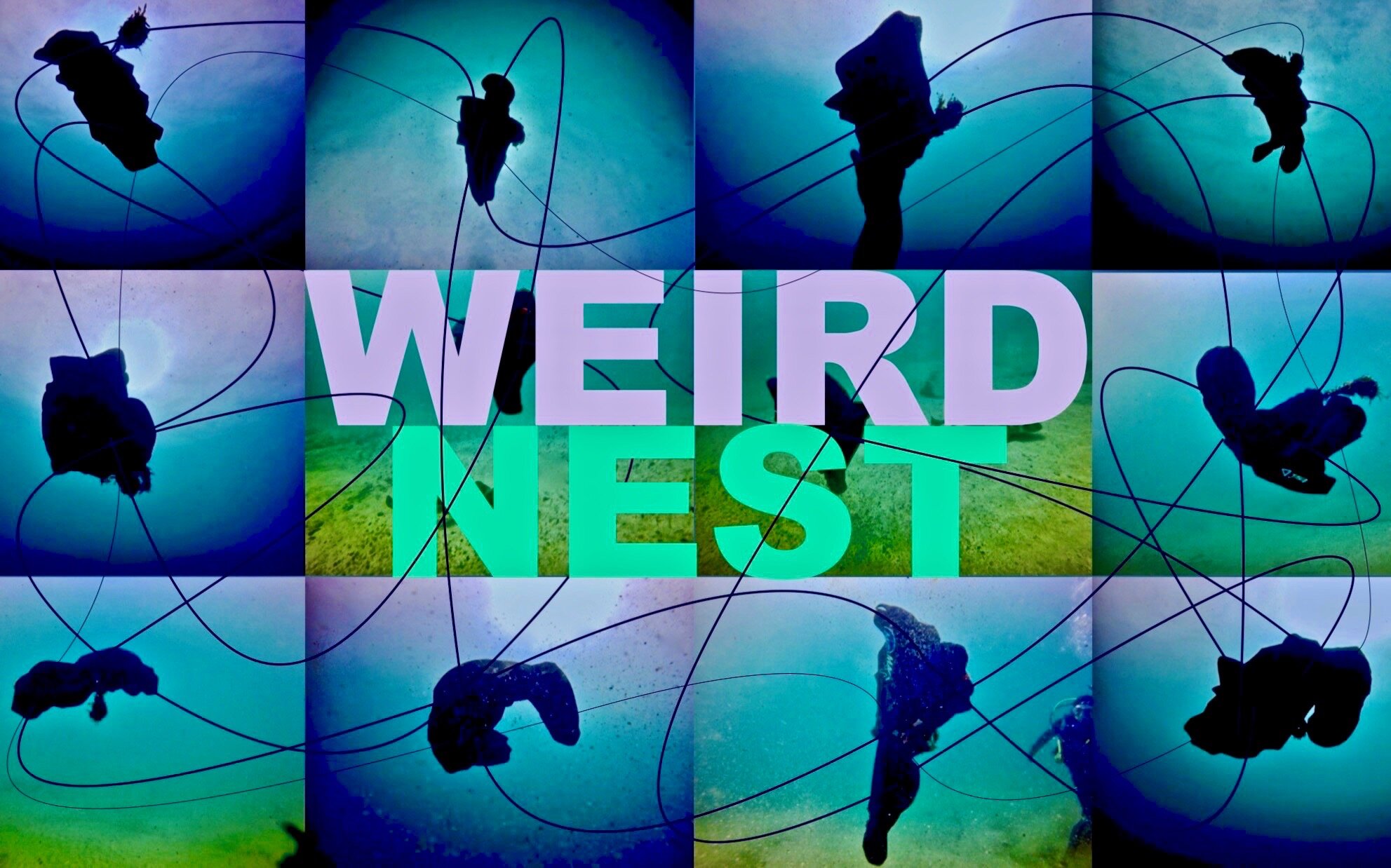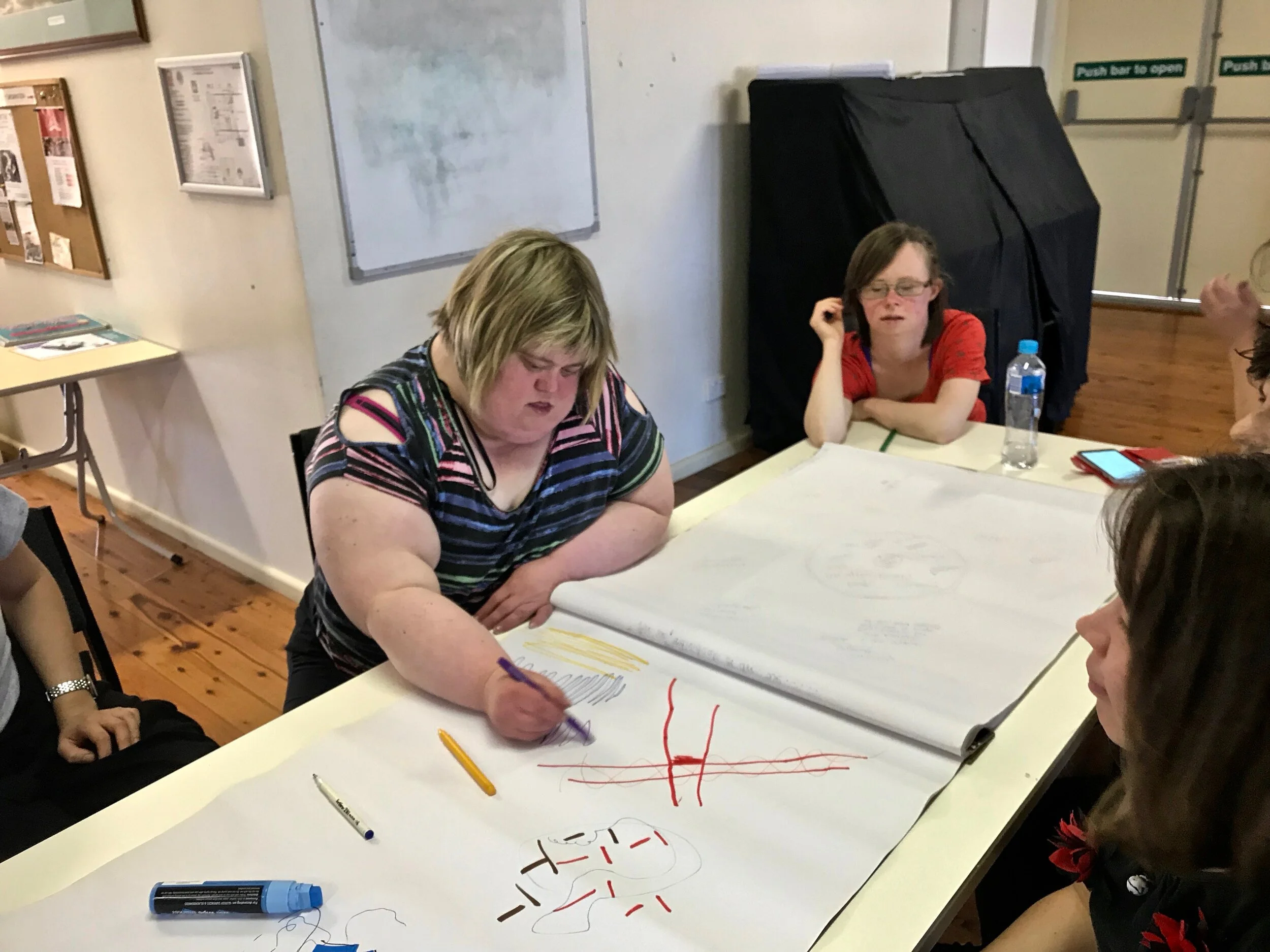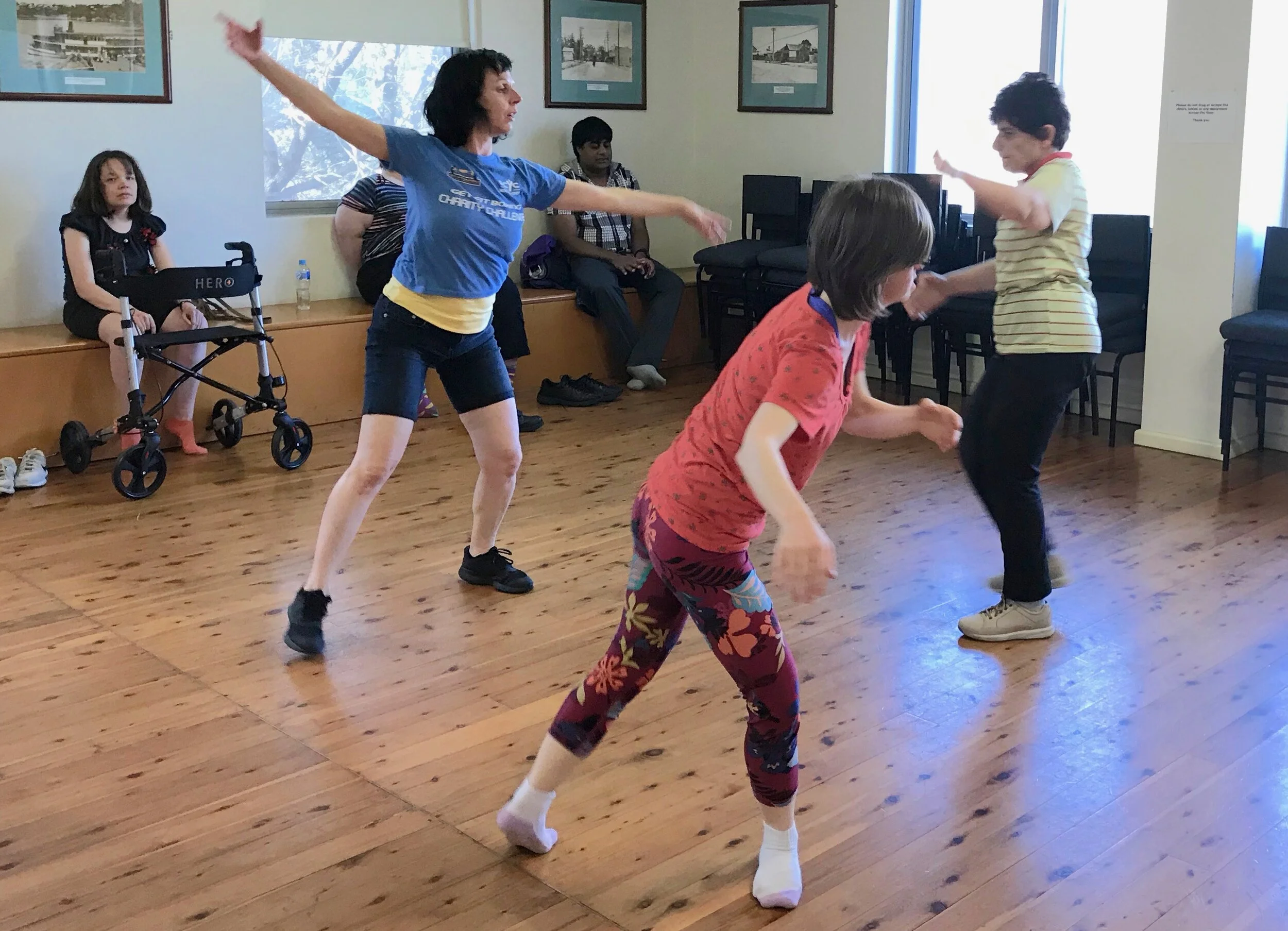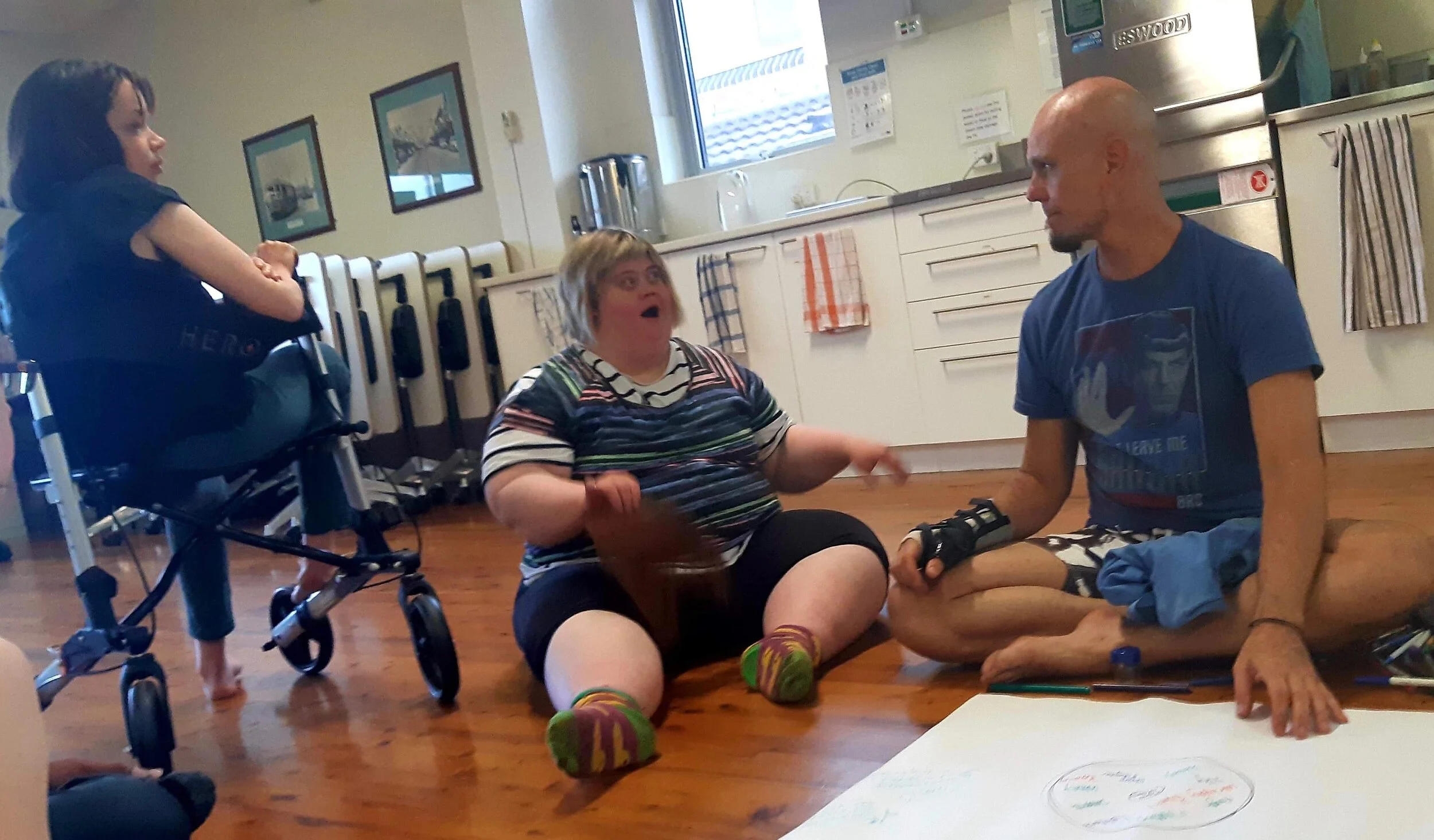More Info Accessible and Inclusive Workshops
2. The 2020 Creative Dance / Movement and Performance Program
Presented by Sydney Community Services and Dean Walsh
Members of Sydney Community Services Dance/Movement Group, Cat and Katherine watching on as Belinda draws the aerial view of her proposed dance geography. Photo by Rosella Massida
Creative Dance, Movement and Performance aims to empower people living with disability, and/or mental health, through developing their creatively embodied expression throughout the year-long program which includes over 30 weekly classes and rehearsal sessions that culminate in an end-of-year performance in a Sydney venue - TBC. Each of these classes and the exercises within them (Dean’s ‘Found In Translation’ methods) explore meaning found within movement and are tailored to each individuals’ experience, access needs and capacity of engagement.
We will be kicking off term 1 with a ‘Warm Data Lab’ – an experience which invites in-depth discussion and the space to explore ideas of human interrelationships. All participants, their families and support communities, are absolutely welcomed to attend. Details.
Term 1 - 20/2/2020 -> 23/04/2020
When: Commencing 20th February, held each Thursday 3:30-5:30pm
Where: Living and Learning Centre, 164-180 Longueville RoadLane Cove, NSW, 2066 Australia
Further info, including booking can be found here.
Approach and Risk Assessment: Accessible and Inclusive Dance/Movement Workshops
Compiled by facilitator, Dean Walsh
Natures of the risks we assess are:
Physical
Emotional
Psychological
Dignity
Class and workshop preparations:
Prior to commencement:
Dean maintains that there is a 4-fold set of interrelating components to be observed towards gaining a more authentic sense of belonging for each participant in a series of classes or one-off workshop events.
1. Access
The first consideration is to ensure (from all organising parties), that a workshop and/or class series is fully accessible for physical, psychology and emotional entry and during the class/workshop. Key considerations are:
being sure that the venue is entirely accessible in the physical sense
ramps for wheelchair and walking frame users
no obstacles that could trip up people who are blind or use walking frames, canes
toilet facilities fully accessible, including railings
that kitchens items of need can be placed within reach for people of short stature and/or stable step ladders available
spaces for people to go where they can have less sensory information loading into them for a while. This can including an outside area, subject to weather and/or headphones and weighted blankets
Are there chairs for those who cannot sit on the ground?
Are their pillows / cushions for those who can but need support?
Are there any potential textured aspects in the room or class that could make people really uncomfortable who have sensory sensitivities? Like carpet, rough blankets etc
Dean and Katherine with Rosemary sitting down and Sama dancing in the background, during a structured improvisation for Sydney Community Services Dance/Movement Group. Photo by Amanda Zhorg
on class commencement:
We hold 5-10 minutes welcome for each workshop and every class that is taught. This is a chance for people to say how they feel, voice any concerns and arrive together in the room and hear what the class might contain. A moment to focus, breath and connect – especially for people who could be very sensory overloaded by activities prior to arriving in the room. It is also a chance for facilitators to ask questions and to ensure that we have all understood the guidelines document. Checking that people have gone to the toilet and have water and food for breaks is important here too.
2. Integration
We embrace the notion of integration as being a two-way street (as opposed to thinking that it is in any way about assimilation of one way of being into another), that is defined not only by generating a space of equality, but more of an emphasis on equity. And one that flows in all directions.
We are inspired by living systems analyst, Nora Bateson’s, word “symmathesy” meaning; learning together. It suggest that we remain open to the understanding that we are all learning, in so many ways, constantly, even those we can’t possibly know, through interdependent forces around us that aren’t immediately obvious.
Dean and Cat during a 5-minute improvised duet in class at Sydney Community Services’ weekly classes 2019.
Once participants, for any given workshop or classes are confirmed, we then ascertain what their individual extenuating access needs may be, prior to the first session commencement, so we can prepare for them.
audio description – do they have their own describers?
Auslan interpretation – will they provide their own interpreters?
captioning of any videos that are being shown
Some, less apparent, access needs may be very personal in nature. As such, an individual, and/or their care giver, may choose not to disclose unless they feel there’s good reason for them to do so. Either way, Dean or other assigned co-facilitators / support workers will not disclose such information to any parties outside the core leadership team. A written agreement for this to be adhered can also be provided. The core team may discuss it so as to mitigate any chance of harm coming to that person or their sense of sustained inclusion.
Other access needs may require all participants in the room knowing of them, so as to avoid:
any unwarranted misunderstandings, misreadings or shock around someone’s sudden ‘behaviour’
encroaching of personal space for people who find this exceedingly confronting
remarks or actions that may offend in any way
needs for some people to sit out from time to time
actions that could leave people out of important aspects of proceedings, i.e feedback sessions going too fast and not letting some who process slowly have their chance to speak, instructions being given only in verbal form (rather than physical/visual as well).
3. Inclusion
This is where the notion of granting access to creative dance/movement/performance-making workshop or class becomes dynamically sustained. The ‘question-constant’ for us is; Does each person feel they are being catered for, both in terms of their access needs in each exercise, and in terms of their gaining a deepening sense of feeling included overall, regardless of their specific disability? With this we can start be more assured that a wider sense of belonging can be achieved.
But this is where the ongoing, consistent and sustained adaptive, translational, communicative, agency-providing work comes in. It requires checking in with individuals and the entire group (participants and facilitators), at regular intervals, around all things that are pertinent to the creative task at hand or their personal needs – thirsty, need to go to the toilet, not coping with the overload of information etc.
Jam and Bread Ensemble from regional Orange, NSW during a film shoot for their first full-length work, ‘Second Nature’. Photographer - Dean Walsh
But also knowing / sensing when to let people have the space to explore and ask for things when we know they are able. Constantly asking in some instances can be invasive and come across as condescension and encroaching on personal space beyond the needs at hand.
Communication across both the facilitator/s and assigned support people is also key here. This mitigates risk through on-the-spot assessment and sets up communication channels - especially where the lead facilitator (as in Dean’s case), also identifies as living with disability and have their own access and support needs. For Dean, these are defined in the facilitation and support item in his access needs documents and are always disclosed and discussed prior to any one-off workshop, or when new support people are hired during term-based programs.
Injury prevention:
People with more profound physical disability may also want to move like others with more mobility. We encourage this. However, where the person is also intellectually disabled and not entirely able to grasp the potential for risks in this instance, it is imperative that two support people are present to assist.
Risk of Dignity / Dignity of Risk:
Where such a person possesses their full intellectual faculty, the support they feel they need must be negotiated. It mustn’t be enforced that they require any more assistance than they deem necessary. In any case, the facilitators and support people must be attentive to this moment, rather than let the person attempt to engage in ways they may never have until this moment of decision. But this is where the ‘dignity of risk-taking’ can be negotiated at this point and is spoken of prior to the exercise being given.
4. Belonging
This is really a subjective feeling / state. It can be a very personal perception and perspective. As such, it should never be assumed that any individual feels like they fully belong and are 100% comfortably feeling this.
For some people this can change in an instant or from day to day. This is why the importance of communication, across facilitators and supporters and participants can never be underestimated. Sustained tune-ins to the ‘question-constant’ can really bring people back into a place of feeling they belong and are being authentically cared for and encouraged. It is an entirely dynamic, ‘access all sensory areas’ way of working.
Embraced with authenticity and open-heartedness, it can be the most engaging, versatile and quietly revolutionary way of coming together around embodied arts practices. By its very nature, when undertaken with a more entirely shared process toward any given outcome, working in this way can be significantly inventive, simply by enabling vastly mixed abilities, diverse methods of expression and a sense that they do have agency. That they do have something to contribute. That they do belong.
on Dean’s embodied arts practice:
Participants in Dean’s 3 day ‘Found In Translation’ workshop during Crossroad Arts’ C.R.U.S.H disability arts access profesional development workshop series. Mackay, Queensland, 2019
‘PrimeOrderly’ is the name of Dean’s dance, performance and choreographic research-based practice that has been developed over the past decade to bring about more accessible and inclusive sense-making processes (embodied not only cerebral), around Climate Change science concerns, in particular, from a subaquatic (marine) focus. It is both a series of embodied methods that can be used to communicate ecological ideas through choreographic treatments, as well as a means to share movement studies and methods that can be engage with by anybody, or mind, as each modulated exercise can be written down, visually mapped / drawn in pictures, ‘streamed’ through other sensory apparatus or engaged with at multiple degrees within the one session / moment.
PrimeOrderly is also used to describe Dean’s overall practice focus on accessible, embodied marine environmental knowledge that can bring all manner of diverse people into a given series of collaborations around subaqueous states, without words dictating everyone’s comprehension of the experience.
On Dean’s accessible and inclusive teaching practice:
‘Found In Translation’ is a more specific and bespoke teaching, training and performance making methodology. It is a unique approach to dance, movement and choreographic training and/or production development. It aims to make these quite sophisticated embodied arts practices more authentically accessible and continually inclusive. It does this through promoting participation, at the varying levels of access needs in the room by utilizing diverse artform practices such as, writing, storytelling, drawing, painting, sculpting, song, video play and set building. There is never only one method being used to generate and compose choreographic ideas.
Jam and Bread Ensemble from regional Orange, NSW during a rehearsal for their first full-length work, ‘Second Nature’. Photographer - Dean Walsh
Working together on new and diverse ideas for ways to dance and move.
Access and Inclusion Dance/Movement Group Guidelines:
When we are working in a group of people who identify as living with disability – physical, psychology, neurodiversity and/or metal health – there are always a number of guidelines and rules we each need to be aware of and adhere to, so we generate the most safe, fun and productive space together.
For the most part, these guidelines circle around how we maintain best practice of access and inclusion, collaboration, respect, share stories and ideas, teach one another dance steps and stories we might write, communicate and engage with one another whilst in class and during any breaks. This is true whether we identify as living with disability, being neurodiverse, having any mental health issue, or none those of us who do not identify with living with any of these.
James Penny in RUCKUS ensemble’s Speed of Life, PACT theatre, 2016
This list below is a guide for us all and should be read by each of us prior to the commencement of any workshop or class series. It can be referred to and discussed whenever anyone needs to bring something up. At the start of any workshop or class series/term (or when any new people show up), we will read through so we all understand what the guidelines are and what it means to adhere to them.
We will all try and be aware of the room we’re working in. Get a sense of the size of the working space (which may change from day to day) and make sure there are no dangerous obstacles in the way of the dance/movement area – like bags, pencil cases, shoes, phones, props, chairs etc
The class facilitator Dean Walsh, is a very sensitive choreographer/director and dancer/performer, with 30 years of experience as a professional, career-based, artist. He has always been interested in outreaching to vulnerable individuals and communities throughout his career and, in the last ten years, has formulated a movement and performance-making methodology that focuses on access and inclusion for all bodies and minds, no matter how profound the difference of our combined disabilities may be.
Dean openly identifies as living with “invisible” disability as an autistic also living with significant ADHD and C-PTSD. As such he is very aware that sensory overloading is real and can be very tricky to live with for any of us. With his extensive experience facilitating diverse needs in a given project, we can be rest assured we’re in good hands.
Dean and Amanda Zhong (Sydney Community Services) support person for this program, as well as all the other volunteer support workers we’ll have for each session, are also very sensitive people and will work closely with Dean to assure everyone in the room is in the very best of sustained support, inclusion and care.
We can feel assured that we are in a safe environment with people all around us who care and want to help us all work together as a group, where the aim is to promote a deeper sense of belonging in these classes, our own lives and the greater world. We all want to be engaged in this through creating a culture based on equality, equity and respect as we explore our own points of view, our lives, our stories and the worlds around us – the natural and the human-made – in ways that make us feel safe and empowered to grow as people.
We should never feel we cannot speak about our access needs before, during and after any class – even if they change several times in any one session.
If we feel scared or overwhelmed about anything happening in the program classes, single workshops or rehearsal sessions, we can always talk, or otherwise indicate, this to the class facilitator so they, and everyone present, know how to assist us.
Respect of other peoples’ space is very important – even if the direction might be to connect physically with another in a duet or trio dance, for instance. If someone says they don’t want to be touched, we must all respect this. We can always do something else. And let’s all be aware that this can change for each person from day to day and moment to moment.
Some people like alone time so they can concentrate and even really focus in on just one thing at a time and for some time. This can help them reorganize their thinking. When someone is working on something and they don’t want to be disturbed, we should respect their need for mental and physical space.
Other people find it difficult to concentrate for more than just a few seconds or minutes at a time – and this can change for them as well. We can always ask for assistance in any exercise, whether that is of a physical, written, spoken or visual art kind.
If we ever want to go to the toilet we should not be afraid to ask the lead facilitator or one of the support people. No one will ever be told they cannot leave the room in such instances.
When we are given times of leadership, for a warm up exercise or choreographing an idea for example, we should not feel embarrassed to ask for assistance or decide you would rather just follow other people leading.
When one of our class colleagues is leading a class exercise or rehearsal session, we should give them as much respect as we give other facilitators.
We should always try our personal best to challenge ourselves by participating in the whole class – even exercises we might not enjoy as much as others – because this is the best way to grow towards becoming more of an experienced, even professional, artist.
We should always aim to be on time to all classes and rehearsals and let Dean or Amanda know if we’re going to be late. Dean’s mobile number is 0421 844 421.
If we know we cannot make the session 24 hours or more prior to it, can we all be sure to email Dean and Amanda on dean@dean-walsh.com and azhong@sydneycs.org
There will always be a First Aid kit on hand so if we ever hurt ourselves we know we can be looked after. Both Dean and Amanda have their First Aid / Emergency First Responder certificates.
The class of 2019 - Sydney Community Services Creative Dance/Movement and Performance
Katherine, Belinda and Dean in class




